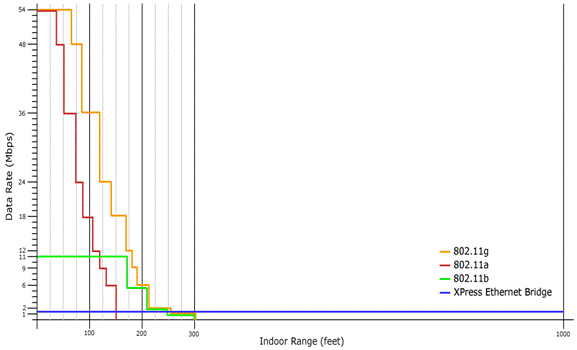Speed vs. Range
802.11g''''s primary function is to transfer data at high speeds (54 Mbps over-the-air and 35 Mbps streaming) at a short range (<300 ft indoors). For long distances the 2.4 GHz wave is smaller and does not penetrate obstructions as well as other ISM band frequencies, such as 900 MHz. The speed of the 54 Mbps connection drops significantly indoors and nearly dies out at 300 feet. It is interesting to note that after 300ft the link is not necessarily broken. Some tests have shown 802.11g working indoors much farther than 300ft, but with reduced throughput to about 1.0 Mbps.
The XPress Ethernet Bridge is designed to work at a low data rate (1.54 Mbps over-the-air and 1.0 Mbps streaming) at long distances (1000-2000ft indoors and up to 15 miles outdoors, line of sight). The 900 MHz is a longer wave than 2.4 GHz, and penetrates obstructions much better. However, the XPress Ethernet Bridge lacks the ability to transfer data at high speeds (54Mbps). The diagram below compares Data Rate vs Indoor Range for 802.11a(5GHz), b, g and XPress radios.

Networking
802.11g supports point-point, point-multipoint and ad-hoc mesh repeater networks. The XPress Ethernet Bridge supports point-point (matched pair) and repeater networks.
Interference
Due to many pre-existing 802.11 WiFi systems, Bluetooth networks, and other license-free products, the 2.4GHz band can be fairly saturated in some areas. Also keep in mind that microwave ovens use 2.4 GHz and can cause significant noise in close proximity. 900MHz is often a more clear and usable band due to less in-band noise.